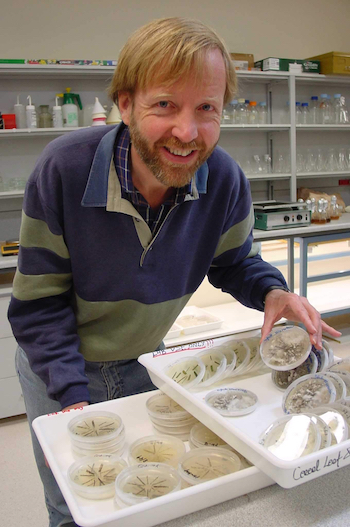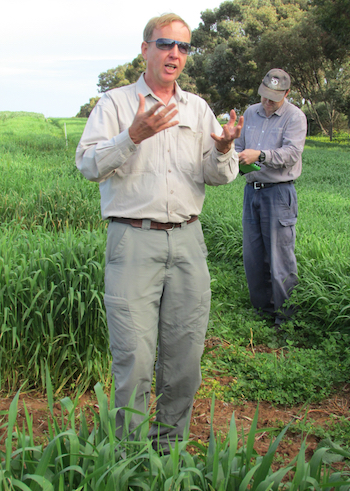Grains industry stalwart Dr Hugh Wallwork has stepped down from his position as principal cereal pathologist at the South Australian Research and Development Institute (SARDI) after 38 years.
Dr Wallwork led the foliar division of the cereal pathology laboratory at SARDI, a division of Primary Industries and Regions South Australia (PIRSA).
In the Adelaide-based role, Dr Wallwork made a remarkable, long-term contribution that has advanced industry knowledge of cereal pathology, both in SA and nationally. He is widely esteemed for his long record of scientific achievement, including several world-first discoveries and tireless research extension efforts.
Over the years, Dr Wallwork had a particularly influential role in the development of on-farm disease management strategies across the country, and cereal cultivars with genetic disease resistance. He is also highly regarded for developing efficient, reliable screening methods for a variety of diseases.
“I’ve been very, very lucky – it’s been fun,” Dr Wallwork says.
His career in the Australian grains industry began in 1982 when he relocated from the UK to Australia for a two-year postdoctoral position at the University of Adelaide’s Waite campus, working with the late Professor Tony Rathjen.
His postdoctoral research examined take-all disease in wheat due to its prevalence across southern Australia, especially SA.
Two years later, on 1 July 1984, he joined the Field Crop Pathology Unit of the South Australian Department of Agriculture, which has since become SARDI.
There, his 38-year tenure as a cereal pathologist, replacing Dr Allan Mayfield, began with a focus on stripe rust disease in wheat, which had emerged as a major problem in SA paddocks for the first time in 1983.
Dr Wallwork was able to communicate his first-hand knowledge of stripe rust disease – mainly its biology and crop impacts – to Australian growers based on his PhD studies in the UK.
His PhD at the Plant Breeding Institute in Cambridge, England, explored the genetics of durable adult plant resistance to stripe rust in wheat.
“When I started the job at SARDI in 1984, nearly everybody in the SA grains industry was interested in stripe rust,” Dr Wallwork says.
“Although it was first detected in Australia in 1979, it did not become a serious problem until 1983. No one knew quite what to do about it, and I had done my PhD on stripe rust in England. I happened to be in the right place at the right time.”
Although Dr Wallwork worked at the same SA-based institute for most of his career, he says there was never a dull moment since the field of pathology was animated by “constant change and diversity”.
“The two areas I enjoyed the most were the diversity of the people and the diversity of the research,” he says.
Research and extension diversity

Dr Hugh Wallwork has stepped down from a 38-year tenure as principal cereal pathologist at the South Australian Research and Development Institute (SARDI). Photo: SARDI
In addition to applied research, Dr Wallwork had a vital role in research extension – communicating pathology research findings to growers and agronomists to facilitate beneficial on-farm practice change – with the aim of minimising disease losses.
In this extension capacity, he served the grains industry as a “conduit conveying information to growers in the most timely, effective way”.
“I have really enjoyed the diversity working with a range of grains industry professionals, from farmers and agronomists to cereal pathologists and plant breeders,” he says.
“The link between research and on-farm practice in the paddock has been very rewarding.
“There was also a sense that the job was making a difference in helping growers, who appreciated the work.”
Diversity was also a major theme in the many cereal diseases he covered, and the broader, dynamic landscape of crop pathology.
Although wheat leaf diseases, especially stripe rust, were an early career focus, his “pathology portfolio” gradually expanded to include a wide range of diseases in wheat, barley and oats. These were mostly foliar diseases, but also some root and stem diseases.
Dr Wallwork was a research and extension expert in five main cereal diseases: scald, spot form of net blotch, net form of net blotch, crown rot and eyespot. Cereal rust diseases (drawing on research at the University of Sydney) and Septoria tritici blotch were also part of his research extension repertoire.
“The industry’s cereal pathology problems have constantly changed over the years.
“You might be focused on one disease in one year, and the next year you are focused on quite a different disease, in response to a new pathogen that has emerged as a problem.”
He has been especially proactive in disease monitoring and identifying changes in pathogen virulence to help growers manage these emerging problems.
Pathology advances
Dr Wallwork was program leader for the GRDC co-invested Cooperative Research Centre for Molecular Plant Breeding from 1997 to 2006. In this leading role, he managed a suite of research to advance genetic resistance to cereal pathogens, such as scald and net form of net blotch in barley, and crown rot in wheat. Throughout his career, he was a staunch advocate for plant genetic disease resistance “as the most sustainable, long-term approach” to managing crop pathogens.
We made a lot of progress in understanding the genetics of plant resistance to a range of pathogens under the auspices of the centre’s molecular marker program.
For example, Dr Wallwork and his team were the first scientists in the world to identify and publish molecular markers for both a wheat gene with partial resistance to crown rot, and for a barley gene with resistance to spot form of net blotch.
In another world first, he was the first person to describe the sexual stage of the fungus that causes eyespot disease. This discovery was made on straw, showing eyespot symptoms, collected from a remote crossroads at Yallunda Flat on SA’s Eyre Peninsula.
When it was cultured in the laboratory, with the collected straw placed on moist sand in a Petri dish, a tiny cup fungus developed, which turned out to be the sexual stage of eyespot (Oculimacula yallundae).
“It was the first time that sexual stage had been found anywhere in the world, so it was exciting to publish that finding,” he says.
 In a world-first discovery, Dr Hugh Wallwork cultured the sexual stage of the fungus that causes eyespot disease in the laboratory at SARDI. Photo: SARDI
In a world-first discovery, Dr Hugh Wallwork cultured the sexual stage of the fungus that causes eyespot disease in the laboratory at SARDI. Photo: SARDI
He also found that a fascinating adaptation, which allows barley leaf rust disease to survive from one cropping season to the next on an alternative host, occurs in SA. The alternative host is a bulbous introduced plant called the Star of Bethlehem (Ornithogalum umbellatum).
Although leaf rust generally cannot survive on stubble, he showed the disease could survive over summer to infect the following barley crop by undergoing three stages of its sexual reproductive cycle on the Star of Bethlehem.
Discovery of this adaptation helped to identify and manage the weed as the cause of barley leaf rust outbreaks in cropping areas of the state where the weed is common, such as the Yorke Peninsula.
Dr Wallwork also helped develop techniques for detecting minor genes for adult plant resistance to net form of net blotch in barley.
This was achieved using barley plants grown under controlled environment conditions at SARDI’s Plant Research Centre at the Waite campus. The research team also examined how different barley varieties responded to net form of net blotch isolates collected from across Australia as part of the study.
“It provided a clear picture of how pathogen populations around the country interact with different barley varieties,” he says.
Although some varieties had more-stable disease resistance, it generally showed net form of net blotch was evolving to adapt to the barley varieties being widely grown in different regions. The patterns of pathogen adaptation gleaned from the research are linked to emerging patterns of fungicide resistance, he says.
In the past few years, Dr Wallwork has concentrated his extension efforts on fungicide resistance as part of the GRDC-invested Australian Fungicide Resistance Extension Network (AFREN).
The network, which aims to help grain growers and advisers tackle fungicide resistance, brings together fungicide resistance experts, communication and extension specialists, and plant pathologists.
“The network has helped to highlight emerging patterns of fungicide resistance, particularly in SA, over the past three years.” Since 2019, for instance, fungicide resistance has become a major problem in net form of net blotch in barley and powdery mildew in wheat across SA.
Admired author

Industry publications authored by Dr Hugh Wallwork are widely used by growers, agronomists and scientists. Photo: SARDI
Dr Wallwork is further admired for his authorship of several industry publications. These publications were part of his “outstanding achievement in communicating research outcomes”, which GRDC recognised with a Southern Region Seed of Light award in 2015.
Two of his books, Cereal Root and Crown Diseases and Cereal Leaf and Stem Diseases, are important reference guides, widely used by growers, agronomists and scientists for disease identification.
He also produced two annual publications: Cereal Disease Guide and Cereal Seed Treatment Guide. Many growers relied on the Cereal Disease Guide to help develop on-farm disease management plans and to assist with cereal variety selection.
Plus, he co-developed the Crop Watch Newsletter in SA with SARDI senior pulse pathologist Dr Jenny Davidson. The newsletter was subsequently replicated in other states because of its effectiveness in communicating pathology developments to industry.
 Dr Hugh Wallwork will be missed by members of the Australian grains industry following his retirement this year. Photo: SARDI
Dr Hugh Wallwork will be missed by members of the Australian grains industry following his retirement this year. Photo: SARDI
Although Dr Wallwork officially retired earlier this year, his passion for crop pathology and service to growers is ongoing.
In retirement, he hopes to contribute to the long-term plant breeding effort that aims to develop genetic resistance to crown rot in durum wheat.
Dr Wallwork considers this “unfinished business” since he discovered the genetic resistance to crown rot in durum, which is yet to be incorporated into a commercial variety.
“We have the technology to provide that genetic resistance, but it takes a long time to develop. I am hoping to help get that job finished, so that farmers have the benefit of crown rot resistance in their durum crops.”
He and wife Kate also plan to travel overseas and refine their colourful English garden at Stirling in the Adelaide Hills, which featured on the ABC’s Gardening Australia in 2016.
Dr Wallwork is replaced at SARDI by Dr Tara Garrard, who has gradually taken over his research, extension and diagnostic roles in cereal pathology.
More information: Hugh Wallwork, 0427 001 568, hughw9@gmail.com; Tara Garrard, 0459 899 321, tara.garrard@sa.gov.au

























































